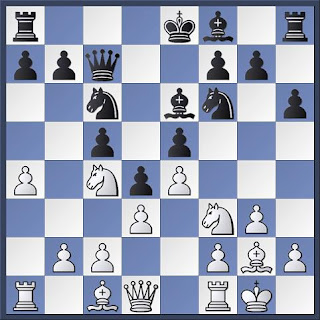There is a certain dynamic in the king's Indian where the opponent closes the position. the KI player posts a knight on the fourth rank of the c-file(QB4), and the opponent develops his queen bishop to the e-file, third rank(K3). Position from my game after 11...Be6
When is it good for the opponent to trade on QB4(c4 in this position) and what should the KI player do about it? The books I have on KID and KIA don't say anything about it, probably most master level players avoid this kind of position against KIA and KID. It is difficult for the opponent to stir up play on the queenside, and even more difficult after the trade.
To explore this position, I switched the colors, because there are more KID games than KIA. I opened the database window (Application Menu=>Open=>Open Database). On the large database that comes with Fritz (database window Application Menu=>Database.cbh), I filtered games looking for this position:
Seventeen games pop up from this filter, only one loss for the KID, and four draws, but the loss was the newest game. The ECO code for all is E94. This is a manageable number of games, so I went through all of them. If there were a lot of games, I would focus on the earlies wins for my side and the latest wins for the opponent.
In the loss (Morozov vs Khruschiov at Peterhof round 5 2009.08.05), black supports the c5 pawn with b6 before white attacks it, and allows white to get a passed pawn on e5 to pair with the d5 pawn. White plays very actively, Black less so. White trades off his bad bishop for the Ng5.
Ideas from the wins:
- transfer rook Ra3-f3
- blockade d-pawn with a Nd3
- retreat Ng5 to h3 when kicked which supports f4 and allows transfer to d3 via f2
- blockade with Bd3(big pawn?).
- Opponent blocks the rook transfer by attacking c-pawn, but that allows advance of the f-pawn and blockade by knight on d-file.
Now that I have a better idea of what constitutes a good position after Be6xNc4. Now I need to go through the game from move 8 with that in mind and make comments, until those plans are obsolete.
From this position before move 8:
I have this annotation for move 8 through 19 from what I have learned:
For a video I have to flesh out some of the descriptions and complete some words for the 8.Nc4 and 18.Bh3 variations, but this is good for analysis.
To finish, I go through the game in Infinite Analysis mode, trying to understand Fritz's suggestions, extending some suggestions into variations and deleting others. Then I add explanations in English as I can.
Flash cards from this game:





No comments:
Post a Comment